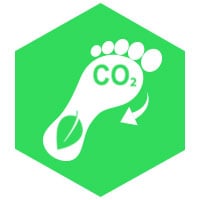What is Sustainable Energy and Why Do We Need It?
Posted on: March 24, 2022
Each year the stakes grow higher in the fight to save the environment and combat global warming. Now more than ever, we’re aware of the damaging effects that our current dependence on fossil fuels holds for our collective futures. One of the key solutions? Sustainable energy.
Fossil fuels (e.g. coal, natural gas and oil) are not only harmful to the planet when burned daily for energy, but they’re also unsustainable as finite resources. Sustainability refers to the concept that all people can meet their basic needs infinitely, without compromising future generations. Sustainability in terms of energy embraces the same principles.
One day the world will run out of fossil fuels. Read on to discover how sustainable energy matters and its significance when it comes to the future of our planet.
What is sustainable energy?
Sustainable energy includes any energy source that cannot be depleted and can remain viable forever. It does not need to be renewed or replenished; sustainable energy meets our demand for energy without any risk of going bad or running out. This is why sustainable energy is the answer to our energy needs.
Furthermore, sustainable energy doesn’t harm the environment (or at most, there is a minimal risk), increase climate change or cost a heavy price. Although there is a cost associated with creating and building ways to capture sustainable energy, the energy sources themselves are typically free.
Examples of sustainable energy sources include wind, solar and water (hydropower). All of which can be considered inexhaustible and widely available to almost everyone. Geothermal energy can also be included as a sustainable alternative energy source. Geothermal energy creates usable energy from the planet’s internal energy sources, such as geysers.
Sustainable energy systems are dependent upon engineers to further progress. For an in-depth introduction to sustainable energy, explore Toolseeram Ramjeawon’s “Introduction to Sustainability for Engineers.” This book provides students with a framework for how to put sustainability into practice. It also highlights the design process and offers a variety of case studies to comprehensively cover sustainable energy.
What is the difference between sustainable and renewable energy?
People often use the terms “sustainable” and “renewable” interchangeably. However, there is a difference between the two: the possibility of replenishment.
Sustainable energy, as highlighted above, is theoretically inexhaustible. It cannot be depleted because sustainable energy sources don’t need to be replenished. For example, think of the sun or wind. Neither resource needs to be created or replaced.
On the other hand, renewable energy is theoretically exhaustible — it uses resources from the earth that can naturally be replenished, such as crops and biomatter. A renewable energy source like bioenergy uses biological masses (e.g. agricultural byproducts like straw and manure) to create energy. Another example of bioenergy is ethanol, which is made from sugarcane and corn. Since these crops can be planted and farmed to generate more energy, it’s a type of renewable energy. For more information on renewable energy systems, take a look at Vladimir Strezov and Hossain Md. Anawar’s “Renewable Energy Systems from Biomass: Efficiency, Innovation and Sustainability,” which explores the ties between bio-related renewable energy systems and overall sustainability:

Another helpful resource is Ram K. Gupta and Tuan Anh Nguyen’s “Energy from Waste: Production and Storage,” which considers how waste from various sources can be used in energy production and storage applications. It similarly discusses the connections between renewable energy systems and long-term sustainability.
Different types of renewable energy are just as important in the search for clean energy options because they don’t pollute the atmosphere, increase climate change or cause more damage to the environment.
What are the benefits of sustainable energy?
There is a broad range of benefits to transitioning to sustainable energy. Below we’ll list the top ways sustainable energy can positively impact our communities and planet:
 Improves Public Health
Improves Public Health
The burning of fossil fuels in coal and natural gas plants is directly tied with many serious public health issues, such as neurological damage, cancer, heart attacks, breathing problems and premature death. When fossil fuels are burned for energy, they release air and water pollution that negatively affect surrounding communities and environments.
However, all of these associated risks can be eliminated by switching to sustainable energy. Sustainable energy sources typically emit no air or water pollutants that can harm public health. They also don’t make a negative impact or strain on local water resources. Meanwhile, coal mining, natural gas drilling and thermal power plants all compete with local agriculture, drinking water and other important community water needs for resources.
 Creates Local Jobs
Creates Local Jobs
Sustainable energy can also help fuel your local communities. Since most facilities and sustainable energy infrastructure must be built locally or in the same county, making the switch helps create jobs and improve the economy. Instead of spending more money importing energy from fossil fuel companies, that money is spent on materials and workmanship to maintain sustainable energy facilities.
 Decreases Your Carbon Footprint
Decreases Your Carbon Footprint
We’re all doing our best to reduce our negative impact on the environment, but there is only so much each person can do. Sustainable energy, such as wind and solar energy, creates zero carbon emissions that can harm the atmosphere and contribute to global warming. It offsets the need for fossil fuels, which are actively increasing climate change and polluting our earth.
Simply switching your own home’s energy source can help cut the environmental impact you and your family have on the planet — and eliminate your dependence on fossil fuels.
 Long-term Cost is More Affordable
Long-term Cost is More Affordable
Sustainable energy can make a huge long-term difference to the electricity and energy costs of our homes and businesses — no matter where you are. Not only are they easily available for little to no cost, but they’re much more cost-effective than traditional energy resources, such as power plants.
Making the financial leap to wind, solar or any other sustainable energy source may seem daunting at first because of installation costs, but the long-term investment pays off in just a few years. In fact, sustainable energy costs decrease each and every year. Depending on your country or state, you may even get tax reductions for choosing sustainable energy. Ultimately, you could end up saving exponentially just by making the switch to a sustainable energy system like solar panels.

Energy Security
Sustainable energy is by definition the most reliable form of energy. It will never deplete and can remove our reliance on imported fossil fuels, which are growing more expensive and less accessible. Sustainable energy also helps to conserve the planet’s natural resources and reduce the pollution associated with unsustainable energy.
Why is sustainable energy important for our future?
When we consider sustainable energy and our future, it’s essential to also understand what the current energy crisis is doing to our planet right now.
Due to human activity, the earth has grown 1.5 degrees hotter since the industrial revolution — a staggering amount in such a short period of time compared to pre-industrial revolution times. Many factors have contributed to this increase, but a major cause is our burning of fossil fuels for energy. The most prevalent greenhouse gas is carbon dioxide (CO2), which has triggered immense global warming.
Although carbon is an essential element within the earth’s ecosystem, there needs to be a sustainable balance — which is not the current situation. Carbon particles have become trapped in the earth’s atmosphere, between the surface and ozone layer. This is insulating our planet and warming it up, which is causing catastrophic effects: glaciers are melting, sea levels are rising and extreme weather events (e.g. hurricanes, heatwaves and floods) are escalating.
Beyond that, finite energy source facilities are polluting the air, water and soil increasingly every day. Besides destroying our natural environments, it’s causing undue harm to the health of people globally.
Although humans have done irreversible damage to the environment, there’s still hope in how we maintain and mitigate repercussions for future generations. The solution lies in how we stop flooding our atmosphere with carbon dioxide and reduce our emissions.
Remember, sustainable energy produces little to no global warming emissions. By choosing sustainable energy resources and committing to clean energy, humans can effectively slow down the acceleration of climate change.
To learn more about the chemistry behind sustainable energy, we have two books that can help you get started. Nancy E. Carpenter’s “Chemistry of Sustainable Energy” is a great resource for students who want to understand the fundamental principles of chemistry that tie into long-term energy solutions, including wind power, fuel cells, solar photovoltaics, biomass conversion processes and next-generation nuclear power.
For a university-level environmental chemistry approach integrated with toxicological chemistry, there is Stanley E. Manahan’s “Fundamentals of Environmental and Toxicological Chemistry: Sustainable Science.” This best-seller focuses on the relationship between sustainability and green chemistry, and how they impact the five environmental spheres (hydrosphere, atmosphere, geosphere, biosphere and anthroposphere).
Additional resources about sustainable energy
Want to dig deeper into what is behind sustainable energy? Discover the science, research and concepts of sustainable energy engineering and more in our broad range of books here.

